Tensions are escalating along the US-Mexico border, not over immigration, but water. The two nations, bound by an 80-year-old treaty, share the Colorado River and the Rio Grande. Severe drought and high temperatures have hindered Mexico's ability to meet its water delivery obligations, leading to increased friction.
Under the 1944 treaty, Mexico must send 1.75 million acre-feet of water from the Rio Grande to the US every five years, while the US sends 1.5 million acre-feet annually from the Colorado River to Mexico. An acre-foot is enough water to cover one acre of land one foot deep, equivalent to about 326,000 gallons. Maria Elena Giner, the US commissioner of the International Boundary and Water Commission, noted that Mexico has only delivered about a year's worth of water as the current cycle nears its fourth year, ending in October 2025.
The Rio Grande, known as the Río Bravo in Mexico, flows roughly 1,900 miles from Colorado's Rocky Mountains to the Gulf of Mexico. Over-extraction for agriculture and urban use, combined with climate change-induced heat and drought, have drastically reduced the river's flow. This variability is why the treaty is based on five-year cycles rather than annual quotas, Giner explained. Despite allowances for shortfalls, Mexico ended two five-year cycles in deficit from 1992 to 2002, marking the beginning of heightened political tensions over water.
As another cycle nears its end, Mexico faces intensified pressure. The North American Free Trade Agreement, which took effect in 1994, spurred significant industrial and agricultural development along the Rio Grande, increasing water demand. This, coupled with population growth and a changing climate, has exacerbated water scarcity. "You have treaties that were meant for a stable climate, but now are trying to be enforced in a climate that is not stable," said Vianey Rueda, a researcher at the University of Michigan specializing in the 1944 treaty.
The water from Mexico feeds into the Falcon and Amistad Reservoirs, crucial for Texas's agricultural and municipal water supplies. Both reservoirs have plummeted to historically low levels, with Amistad at less than 26% capacity and Falcon at only 9.9% as of mid-June. Brian Jones, a farmer in Hidalgo County, Texas, described the dire situation facing local farmers. "Farmers in the Rio Grande Valley of Texas are either out of water or running out of water quickly," he said. The state's sugar industry has been particularly hard hit, with the closure of the only sugar mill in February after more than 50 years of operation, attributed to Mexico's failure to deliver water.
Political leaders in Texas are demanding action. Rep. Monica De La Cruz, supported by Senators Ted Cruz and John Cornyn, has pushed for withholding aid to Mexico until it complies with the water treaty. This stance reflects the deepening frustration among Texan farmers who are facing the prospect of another scorching summer without adequate water.
However, the water crisis is equally severe in Mexico. The country is enduring its most expansive and severe drought since 2011, with nearly 90% of its territory affected. The situation in northern Mexico is particularly dire, with significant declines in dam and groundwater levels. Salvador Alcántar, a congressman in Chihuahua, highlighted the severity of the situation, noting that no rain had fallen in over eight months. In 2020, tensions flared when the Mexican government released water from a Chihuahua dam to meet treaty obligations, leading to protests and a deadly confrontation.
The challenge of renegotiating an 80-year-old treaty lies in the dependencies it has created. Amendments to the treaty, known as "minutes," are the usual method for addressing issues, from data-sharing to water delivery changes. Negotiations for a new minute aimed at ensuring reliable water deliveries from Mexico stalled at the end of last year but are expected to resume with the new Mexican administration.
Relying on unpredictable storms to alleviate water scarcity is a precarious strategy. Instead, there is a push for tools to build drought resilience and promote water conservation. Claudia Sheinbaum, Mexico's president-elect, has prioritized water issues, which may offer some hope. However, the US could have a new president by the end of the current five-year cycle, potentially complicating relations further.
Ultimately, both nations need to recognize that water-sharing agreements must adapt to the changing climate. "Instead of seeing water as a zero-sum game, where one party's gain is contingent on the other's loss, both sides should realize they are suffering the same thing because of climate change," Rueda said. "Then you start eliminating that zero-sum game, you start saying we're both losing essentially. Nobody's actually winning."






